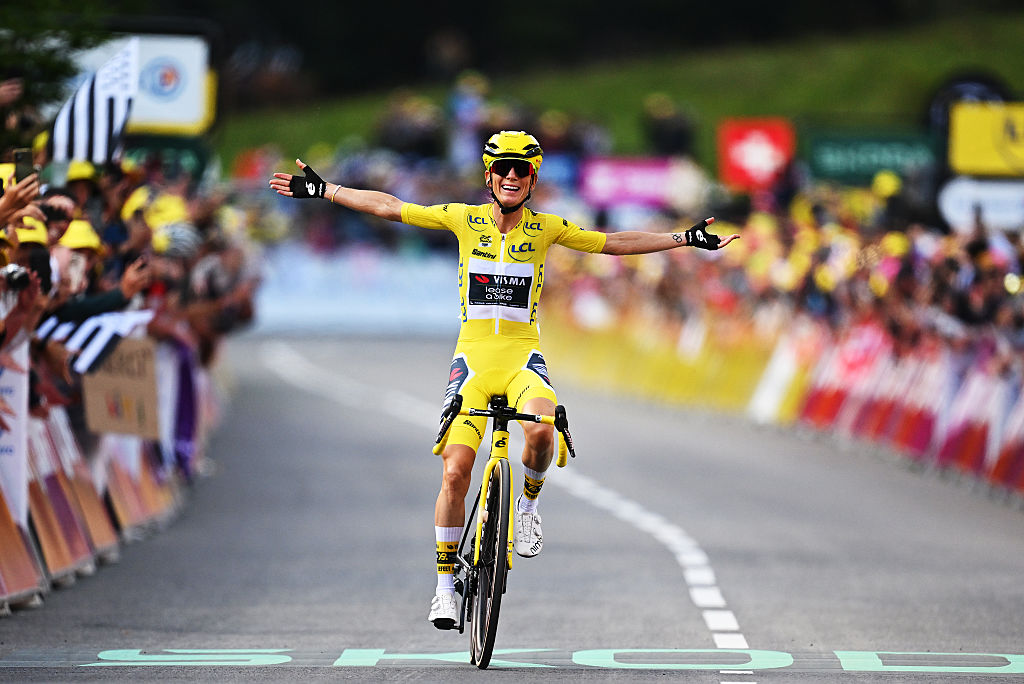The day that many riders dislike, the team time trial is an intense stage conducted over 67.5 km, which took the riders 70-75 minutes to complete. If you're on a team that wants to excel you'll have needed to practice riding all-out in TTT formation many times. The well-drilled teams who are aiming to win the Tour - such as CSC, Discovery, Gerolsteiner, Phonak and T-Mobile - would have practiced these routines. This will include, riding in single pace lines, double pace lines and not having the very fit riders destroy the less fit riders (unless the team can afford to shed and lose riders).
The order of the team in part depended on the size of the riders - it's usual for bigger riders to be in front, as a tall rider trying to shelter behind a small rider won't offer the taller rider much protection. Fitter riders will also tend to do longer turns on the front, but hopefully not at a power output that shells the weaker riders!
Physiologically, the demands of a TTT are slightly different to an individual TT. In an individual TT, assuming the course is flattish, it's better to put out a fairly constant power output. For an individual TT it's your sustainable TT power and the drag that you create that result in your specific time. For a short TT such as the one that opened this year's Tour, it's imperative to have a high lactate threshold (which is highly correlated with sustainable TT power) and a high maximal aerobic power (MAP). During longer TTs it's more important to have a high TT power.
However, during a TTT riders will vary between riding at high intensity and recovering at lower intensities. The recovery portion is always determined by your aerobic capacity. The 'on' portion of a TTT will demand that you have a high a sustainable TT power and a high MAP - it's likely that the 'on' portion will see riders heart rate and power go beyond what they normally produce during a TT. Riders will likely be putting out 400 - 500 W when on the front (depending on their size and fitness) and their heart rates will likely be around 90% of their maximum. Plenty of pain then!
With the effort so high during today's stage it's no wonder that many team shed riders along the route. One reason is that some riders will have done big turns while on the flatter part of the route, knowing that they may struggle on the hills towards the end and would slow the team down. Others may have simply miscalculated or been riding at too high an intensity and then popped off the back. With several of the teams, we saw only the minimum of 5 riders finishing together. When riding at such high intensity, and having to ride in such close proximity to your teammates it's imperative to ensure your bike handling skills remain good.
Today we saw the maillot jaune, Dave Zabriskie (CSC), go down at just over a kilometer from the finish. It appears that he touched wheels with the rider in front, and then hit the road heavily. With Ivan Basso being the CSC rider for the general classification, and with the stage being so closely fought, CSC powered home, and left Zabriskie to soldier on by himself around a minute and thirty seconds down. It's possible that due to the extreme efforts Zabriskie and the others in the CSC team were making, that fatigue would have been very high. This would have impaired any judgements Zabriskie was making in relation to the wheel in front and the riders around him and possibly precipitated the crash. It's always upsetting to see a race leader lose their lead in such a way. I'm sure though Dave be able to challenge again in later Tours.
The latest race content, interviews, features, reviews and expert buying guides, direct to your inbox!
With the results in we can see who the real contenders are and who is going to be at a disadvantage once the race hits the mountains. Phonak and Gerolsteiner didn't do as well as they hoped, dropping Landis and Leipheimer respectively further away from the top of the GC. On the other hand Discovery, CSC and T-Mobile were close to each other (in the case of Discovery and CSC very close). The challengers to Armstrong will come from the CSC and T-Mobile team.
During a TTT nutrition is critical, riders will need to take on carbohydrate-electrolyte drinks to maintain adequate hydration and energy, and they will also likely use some gels as well - hoping to prevent the dreaded 'bonk', when your stored carbohydrates (glycogen) run out.
After the stage, like any other, post exercise nutrition is critical. The riders will need to eat plenty of carbohydrates, with maybe a small amount of protein, and ensure they stay hydrated as well.
